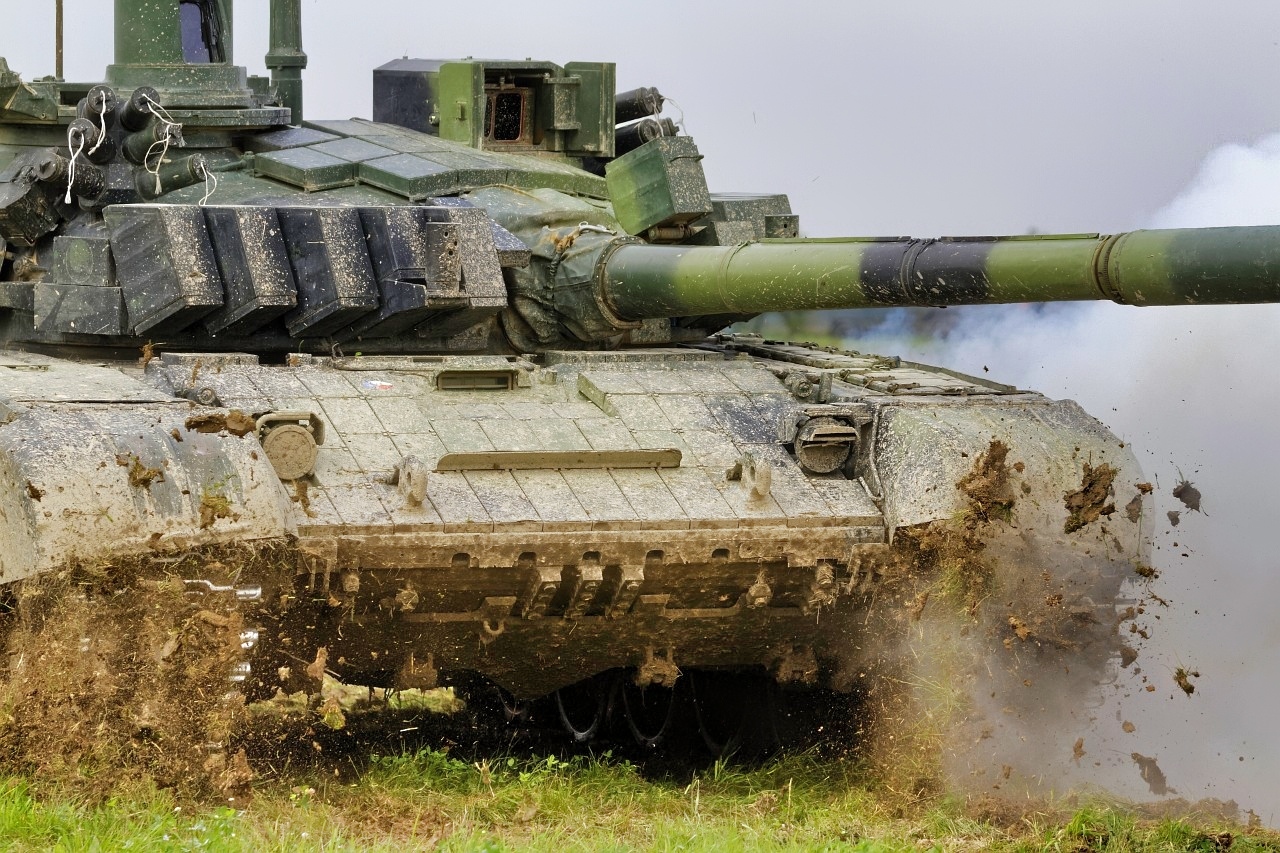Key Points – The Soviet-era T-72 main battle tank sees extensive use by both Russia and Ukraine, but with differing modernization approaches significantly impacting battlefield performance.
-Ukrainian T-72s, often donated by NATO members and upgraded with Western assistance (e.g., Czech T-72EA with advanced optics/armor, Polish T-72M1R with digital comms/thermals), reportedly hold an advantage in long-range engagement and offensive lethality.
-Russia, conversely, has focused its T-72 upgrades on survivability, notably by equipping its T-72B3M variants with the new Arena-M active protection system designed to counter anti-tank guided missiles, a response to significant armor losses.
The T-72 Tank Duel: How Upgrades Are Shaping Armor Battles in Ukraine
The Russian T-72 is a Main Battle Tank (MBT) that dates back to the Soviet era.
The “T-72” designator is a feature of the old USSR’s weapons design process in which MBTs were given a model number based on the year they were first developed, in this case 1972.
The T-72 is an MBT produced in the largest numbers of almost any other tank used in modern militaries and in multiple variants.
The more modern T-90M, which is produced at the UralVagonZavod (UVZ) plant in Nizhni-Tagil in the Urals, is actually an evolution of the T-72 design.
This weapon system has been used significantly by both the Russian and Ukrainian forces in the war, and it is one of the weapon systems used by both sides in the conflict in the most significant numbers.
The T-72 tanks used by the Russian military are produced on the UVZ assembly lines.
However, the T-72s used by the Ukrainian military have been provided by donor nations or were already in Ukrainian service when the war began. Many of the former Warsaw Pact nations, which are now some of the newer NATO member states, have also donated much of their Russian-designed hardware to Ukraine, which keeps Kyiv supplied with these models.
European Assistance for Ukraine T-72s
T-72s provided to Ukraine have not only come from the former Soviet satellite states but from western allied nations as well. In February of this year the UK announced a weapons and military assistance package for Ukraine valued at £150 million that included modernized T-72s as well.
Several European nations as well as the United States have supplied T-72B and T-72M variants to Ukraine, but they are models that have been upgraded to conform with the requirements of the current-day battlefield. Under a US-funded program, the Czech Republic has been refurbishing and delivering modernised models, designated the T-72EA.
This model is retrofitted with advanced optics, improved add-on armor protection, and advanced mobility. From Poland Ukraine has received the T-72M1R variants that were upgraded with digital communication and thermal imaging sites, both of which have increased their effectiveness in combat.
The Netherlands and other European nations have financed modernization projects for the T-72s for Ukraine. The total assistance efforts to improve these T-72s in the field by providing more advanced sensors, targeting, and fire control systems have given the Ukrainians the advantage in armored operations against the Russian military.
Effectiveness of Russian Models
The Russian military has also improved its T-72s, but its upgrades have been focused more on improving the protection and survivability of the T-72s.
This is opposed to how the Ukrainian tanks have been modified to increase the lethality of their offensive capacity.
Video footage shot near the frontlines confirms the Russian Army has deployed a new T-72B3M MBT variant. These units are now sporting a modern version of the Arena-M active protection system.
Equipping these T-72s with this protective technology came after previous reports that the new T-90M main battle tanks in production at UVZ were being integrated with the Arena-M system. Later reports were that the T-72s being modernized at the plant would receive the same new Arena-M version.
Before the more widespread use of the Arena-series system, Russian tanks were mainly covered with the previous-generation Shtora soft/reactive anti-missile protection system. This system could not engage incoming projectiles and therefore could not defend against any anti-tank guided missile (ATGM) with a tandem warhead.
The Arena-M is guided by a mast-mounted radar system that sweeps the surrounding area for incoming missiles or other threats. When any incoming projectile is detected, the system tracks and calculates its trajectory and then deploys a protective munition, almost like a shaped, grenade charge.
This destroys the missile before it can even impact the tank’s outer hull. A more well-known system that is designed on the same principle is the Israeli-made Trophy, which was integrated onto the Israel Defense Forces’ Merkava IV tanks beginning in 2008.
Earlier versions of the Russia-made equivalent had been seen at expos since the early 1990s. Several designs for this kind of armored vehicle protection system were developed in Russia and Ukraine. In almost all cases, the lack of funding for these programs has kept them from being widely deployed until now.
Both sides are continuing to use the T-72. Still, the advantage goes to the Ukrainians, who have been more successful at using the tanks at longer ranges due to the addition of several western upgrades than their Russian adversaries.
About the Author
Reuben F. Johnson is a survivor of the February 2022 Russian invasion of Ukraine and is an Expert on Foreign Military Affairs with the Fundacja im. Kazimierza Pułaskiego in Warsaw. He has been a consultant to the Pentagon, several NATO governments and the Australian government in the fields of defense technology and weapon systems design. Over the past 30 years he has resided in and reported from Russia, Ukraine, Poland, Brazil, the People’s Republic of China and Australia.
Military Matters
France ‘Sunk’ A US Navy Aircraft Carrier in a Wargame
US Navy Submarines Can Crash Into Underwater Mountains and Survive











Pingback: Russia Has Lost over 3,000 Tanks in Ukraine War and Can't Replace Them - National Security Journal